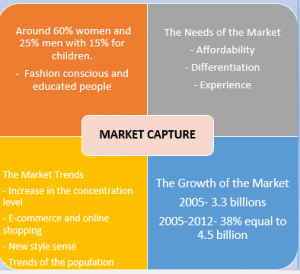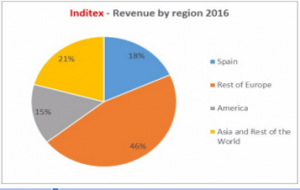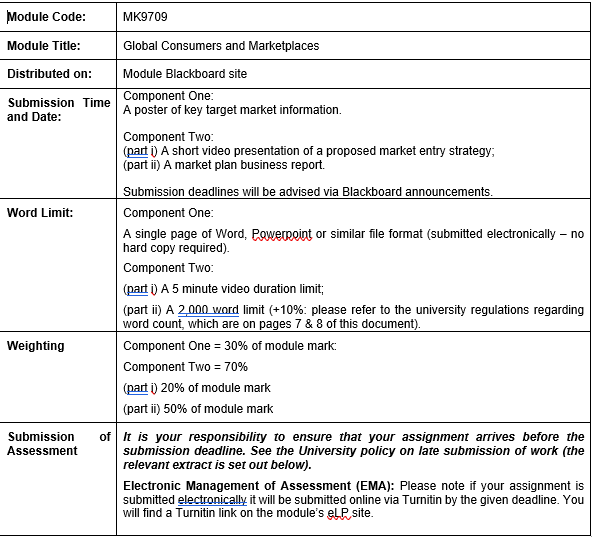MK9709 Global Consumers and Marketplaces
Section I: Critical Evaluation of Zara in established markets
Zara is fast fashion brand that was initiated in Spain. Zara provides its customers with a diversified line of products. This brand deals in products like clothing, accessories, footwear, swimwear, perfumes as well as beauty products.
Zara is known to be one of the most successful brands across the globe and has experiences tremendous growth and success in its business since the year 1975. The main objective of the business provides varied variety and passion for fashion to the diverse group of customers. The company adores its customers and provides for their demands in the most ambitious and acknowledgeable manner (Ghemawat, Nueno & Dailey, 2003).
Availability of Products
Zara indulges in the successes it enjoys today through the strategy of supplying its customers with trendy and fashionable products (Garro, 2011). The fashion industry changes drastically in a very short span of time and Zara maintains to keep up with the pace and enhance its collection based on the rapidly altering fashion trends.
In fact, Zara’s motive its to stay at par with the change in fashion in the rapid manner so that it can avail its customers earliest in comparison to its competitors. Zara commercializes its strategy by predicting and providing the customers with the upcoming fashion trends and only manufactures limited stock with diversity in the variants of products and styles (Tokatli, 2008).
Customer Co-creation and Use of Technology
Zara is eligible in availing the products to its customers in the most rapid ways possible due to the reason that they study and acknowledge the demands of the customers in the most detailed manner. The employees at Zara retails store makes it mandatory to understand the requirements and the expectations of the customers for the company to manufacture products that would be accepted and appreciated in the market. The company indulges in training the employees to become significantly sensitives to the customer demands and needs.

They are expected to make notes and carefully listen to the reviews and feedbacks from the customers. Not only this, the company also empowers its staff to address any new ideas or patterns for their clothes or any other products since the team at stores address the customers on a daily basis and they would interpret their demands in a more precise manner (Tommasetti, Troisi & Vesci, 2015, June).
In complying by the rule of manufacturing what the customer wants and also availing the product in the stores before any of its competitors, Zara invests in using the most cutting-edge technology for information sharing purposes (Kang & Sung, 2010). The use of Radio Frequency Identification Technology enables Zara to make rapid manufacturing and supplying of products to the customers.
Zara has been multi-dimensional and this has enabled the business to expand and thrive in the global market as well. The use of efficient technology and flawless internal operations through training of employees has led the company to become one of the best companies for fast fashion (Ardley, McIntosh & McManus, 2020).
Uppsala model of Internationalization
IT is one of the key strategic elements that Zara has adapted since its planning for internationalizing or globalizing its brand. This approach defines that the business must understand the local and domestic structure as well as sales before entering the international market.

This will help the brand in evaluating the marketing strategies, the consumer behaviour, resource utilization and the complexity required in the operations of the organization (Bhardwaj, Eickman & Runyan, 2011). To enter the international market, this theory states that brand must initially focus on the countries or the markets that are close to the domestic ground. The motive behind this theory of the model is that any contingency could be tackled or avoided if it is closer to the domestic country.
Zara’s net sales increased in the year 2011 with 79% through its international presence and activities. The model also helped Zara in ascertaining the mode of entry in the new markets through strategizing the placement of resources and the demand for the products in the global market.
Zara is termed as the “Fast fashion retailer” because of its tow most important elements that have evolved through the use of the Uppsala model are accessibility and acceptability (do Nascimento João, Carlos Freddo, Negrão de Figueiredo, & Maiochi, 2010). Zara has also adopted the differentiated theories of the model which refers to the fact that it is s a born-global retailer and that Psychic distance is not relevant to the internationalization process. Zara believes that with time, the knowledge of the market and its determinants could be assessed (Matic & Vabale).
Zara has been established various such theories and strategies in order to place its product to the right category of the customers through globalization and creating a very agile supply chain that enables the company to operate worldwide and maintaining 17 subsidiary manufacturing outlets across the globe. The responsiveness that Zara owns to comply by the changing fashion trends are also the sheer results of it strategizing (Mo, 2015).
Section II: Strategy Analysis to entre a new market
Introduction
The market that I am proposing for Zara to enter is the United Kingdom. INDITEX represents that Zara is the major selling brand in comparison to other fast fashion retails. The paper will also address various strategies and market study related to the entry of the company in the new market, which will be directly towards increasing the sales of the brand. Zara is settled in 86 countries as of now and its growth perspectives in global business context is impeccable. Up until now, the brand Zara has been widely accepted by the consumers and the economy in very country.
Consumer Analysis and Characteristics of the Target Market
Consumer Analysis
The consumers in UK possess insightful knowledge about fashion and the current trends. They have the aspiration to explore fashion trends and buy products that match the latest trends across the globe. The UK fast fashion market is more devoted and inclined in using their energies to attaining various and diversified fashionable elements in comparison to people of any other country.
The UK fast fashion market is known to be very indulging and mature which represents that the growth of brand in this area will reflect positively in the company’s statements. Although, it is important to note that the UK population is known to possess a conservative attitude that automatically creates a challenge for Zara but the right products along with the different placement strategies and knowledge of the target market could resolve this challenge and turn it into an opportunity (Grey, 2018).
UK population and the income capacity also plays a vital role in assessing the consumer preferences and analysis. There is a consumer segment in UK that represents the presence of high-income level consumers various fast fashion brands (Rahman & Mannan, 2018).
The consumer mentality in this country significantly states that the high-income consumers are inclined towards such fast fashion brands in order to justify their higher hierarchy of the self-image and achievement of their self-value. The consumers in UK have also been noted to follow a particular pattern when purchasing fashion brands. The consumer prefers to analyse the design first, the quality of the products stand second and lastly the price of the products (Jiang, 2020).
Target Market
The main segment of the market that would be focused on to attempt successful sales for Zara in UK are the young, conscious and the sensitive consumers that are inclined towards reading and following fashion trends in a broad aspect. The young adults belong to the age group of 20 and 30, whose income would also be mid-ranged, keeping affordability in mind.
The female section in the country will also be equally targeting since in the United Kingdom, females respond to the fast fashion brands in a more assertive and active manor that any other demographics. The aim would be to acter customers of all age group with diversified products but the major agendas in the target market has been mentioned above. Like any other economy, Zara expects to thrive in this sector as much as in any of the other countries with providing the customers products that are designed based on their demands and the preferences.
Proposed Market Entre Strategies- Critical Analysis
UK is culturally different country that other where Zara has been conducting its operations. There are various opportunities that Zara could explore in UK based on these different modes and strategies of entering a new market. The three basic elements that Zara employs in its business when entering a new market are as follows:
- to acquire a faster turnover time in a new marker, Zara employs a vertical integration.
- For expansion in the new market, Zara indulges in subsidiaries, joint ventures and franchises.
- The most important toll is opening of stores for faster promotion and cost cutting for advertisement.
The most suggested expansion elements for the UK market are opening of the stores through franchising. Zara can indulge in different location of the country and place stores for the sales and attraction of the customer base (Lopez & Fan, 2009).
Advantages of Opening Stores through Franchising
The physical stores attract the maximum attention from the customers and it has been established that these stores provide the company with competitive advantage in comparison to the other brands. The customers will be able to address the products of the company in a more detailed manner and the brand will also be able to read and analyse the customer preferences in a more described fashion (Ferdows, Lewis & Machuca, 2003).
The sales of the company will also find elevation when they add the online aspect to the sales perspective. The growth of online business through the retail stores have also become very prevalent and customers find it easy to conduct business and buy products. The online process also helps in resolving customer queries and confusions. The setting up of stores in UK would help the brand to create a different and high level of services for the customers and also challenge the competitors in a healthy at proficient manner (Caesar, 2010).
Suggested Marketing Mix Strategy
Product Strategy: Zara must focus on providing mainly for the females in the United Kingdom. It must act as a one stop solution to the customers when they shop for fashionable products. The products must not be restricted to only clothing. But Zara should indulge in providing the customer with male and female both products along with kids wear as the market deems fit to be. Zara should also focus on the sustainability factor because the consumers in UK are very enlightened and informed of the sustainable practices and the waste products by the large brands (Solimun & Fernandes, 2018).
Pricing Strategy: The prices that Zara provides to the existing markets are based on the mantra “high on fashion and low on prices.” Since UK is the international market, the brand must focus on keeping the prices of its products to a limited range and they must cater to the demands of the mid-ranged income consumers (Singh, 2012).
Place and Distribution Strategy: Along with physical stores and online services, Zara must focus on building its supply chain through the use of high-end technology since it will provide the brand with more competitive advantage. The employees in the international market must be trained enough to keep the stores filled with stock, but not abundantly because it will only incur losses due to change in the fashion trend.
Promotion and Advertising Strategy: Zara does not invest too much in advertising. Its objective is to provide quality products to its customer and let the product promote the brand and its authenticity. Opening stores would anyways provide the brand with recognition and acceptance in the UK market but the online platform could be explored for easy and affordable advertisement and promotion activities (Mayrhofer & Roederer, 2016).
References
Ardley, B., McIntosh, E., & McManus, J. (2020). From transactions to interactions: the value of co-creation processes within online brand consumer communities. Business Process Management Journal.
Bhardwaj, V., Eickman, M., & Runyan, R. C. (2011). A case study on the internationalization process of a ‘born-global’fashion retailer. The International Review of Retail, Distribution and Consumer Research, 21(3), 293-307.
Caesar, J. (2010). Zara launches online retail store. BBC. Retrieved from https://www.bbc.com/news/business-11155437
do Nascimento João, B., Carlos Freddo, A., Negrão de Figueiredo, G., & Maiochi, A. P. (2010). Internationalization In The Fashion Industry: The Zara Case. Revista Galega de Economía, 19(2).
Ferdows, K., Lewis, M., & Machuca, J. A. (2003, January). Zara. In Supply Chain Forum: An International Journal (Vol. 4, No. 2, pp. 62-67). Taylor & Francis.
Garro, A. (2011). New product demand forecasting and distribution optimization: a case study at Zara (Doctoral dissertation, Massachusetts Institute of Technology).
Ghemawat, P., Nueno, J. L., & Dailey, M. (2003). ZARA: Fast fashion (Vol. 1). Boston, MA: Harvard Business School.
Grey, A. (2018). Analysis of the customer experience: Zara Fashion UK [Blog]. Retrieved from https://blogs.brighton.ac.uk/agrey/2018/10/26/analysis-of-the-customer-experience-zara-fashion-uk/
Jiang, S. (2020). A Comparative Analysis of Chinese and British Consumers’ Consumption Behaviours and Attitudes Toward Fast-Fashion Brand as Zara and H&M. Asian Journal of Social Science Studies, 5(2), 17.
Kang, J. H., & Sung, Y. Y. (2010). The impact of information technology on the process innovation and competitiveness in the fashion industry-Case study of fast fashion: ZARA. Journal of the Korean society of Clothing and Textiles, 34(1), 1-13.
Lopez, C., & Fan, Y. (2009). Internationalisation of the Spanish fashion brand Zara. Journal of Fashion Marketing and Management: An International Journal.
Matic, M., & Vabale, V. Understanding internationalization patterns of Zara.
Mayrhofer, U., & Roederer, C. (2016). Zara: The international success of fast-moving fashion. HAL.
Mo, Z. (2015). Internationalization process of fast fashion retailers: evidence of H&M and Zara. International Journal of Business and Management, 10(3), 217.
Tokatli, N. (2008). Global sourcing: insights from the global clothing industry—the case of Zara, a fast fashion retailer. Journal of economic Geography, 8(1), 21-38.
Tommasetti, A., Troisi, O., & Vesci, M. (2015, June). Customer value co-creation: a conceptual measurement model in a Service Dominant Logic perspective. In Naples Forum on Service (Vol. 15, pp. 1-31).
Singh, M. (2012). Marketing mix of 4P’s for competitive advantage. IOSR Journal of Business and Management, 3(6), 40-45.
Solimun, S., & Fernandes, A. A. R. (2018). The mediation effect of customer satisfaction in the relationship between service quality, service orientation, and marketing mix strategy to customer loyalty. Journal of Management Development.
Rahman, M. S., & Mannan, M. (2018). Consumer online purchase behavior of local fashion clothing brands. Journal of Fashion Marketing and Management: An International Journal.
Know more about UniqueSubmission’s other writing services:


